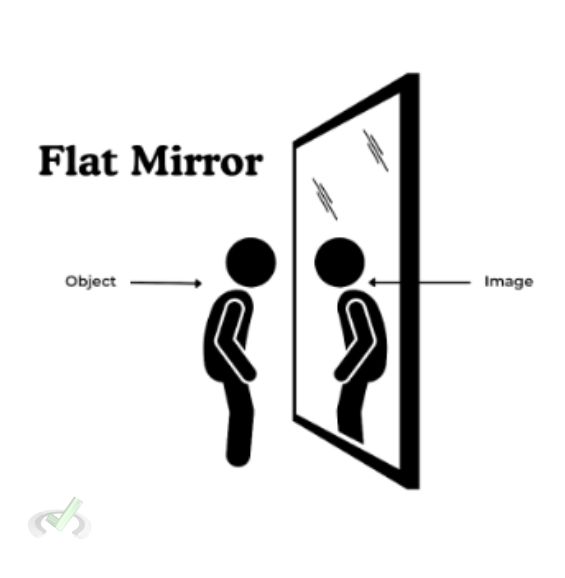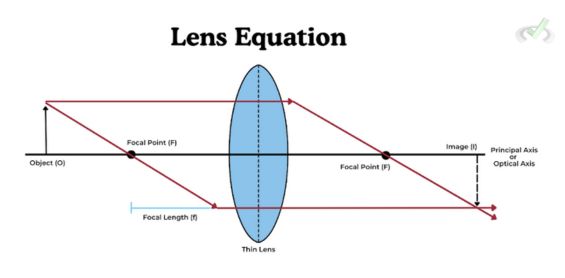Think about the last time you used a mirror to check your reflection or a magnifying glass to examine something small. These everyday tools, mirrors, and lenses are essential in shaping how we see the world.
Mirrors reflect light to create images, while lenses bend light to focus or spread it. Understanding the principles behind these tools is crucial for mastering their applications in various technologies, from eyeglasses to cameras.
I. Types of Mirrors
Mirrors come in different shapes and sizes, each with unique properties that determine how they reflect light.
Flat Mirrors
Flat mirrors, also known as plane mirrors, have a flat surface. They reflect light back at the same angle it hits the mirror, creating an image that appears the same size as the object.
Convex Mirrors: These mirrors curve outward like the back of a spoon. They spread light out, making objects look smaller but allowing a wider field of view. These are often used in parking lots and car side mirrors.

Curved Mirrors
Curved mirrors can be concave or convex. Each type has distinct characteristics that affect how they reflect light.

- Concave Mirrors: These mirrors curve inward like the inside of a spoon. They can make images appear larger or focus light to a point. Makeup mirrors and telescopes often use concave mirrors.
- Convex Mirrors: These mirrors curve outward like the back of a spoon. They spread light out, making objects look smaller but allowing a wider field of view. These are often used in parking lots and car side mirrors.
II. How Mirrors Work
Mirrors function based on a simple yet powerful principle of light behavior.
Reflection
Mirrors work based on the fundamentals of reflection. When light hits a mirror, it bounces back. The angle of incidence (the angle at which light hits the mirror) is equal to the angle of reflection (the angle at which light bounces off).
This is why you can see your reflection in a mirror. The light from your face hits the mirror and reflects back to your eyes at the same angle.
III. Types of Lenses
Lenses are designed to bend light in specific ways, which allows them to focus or disperse light.
Convex Lenses
Convex feature lenses that are thicker in the middle and thinner at the edges. They bend light rays inward to a point known as the focal point. Convex lenses are used in magnifying glasses and cameras.
Concave Lenses
Concave are lenses that are thinner in the middle and thicker at the edges. They spread light rays outward. These lenses are used in devices like peepholes and glasses for nearsighted people.
IV. How Lenses Work
Lenses change the direction of light through a process called refraction.
Refraction
Lenses work through refraction, which is the bending of light as it passes from one medium to another. Light entering a lens changes speed due to the lens material, causing it to bend.
Convex lenses (thicker in the middle) focus light to a point, making images appear larger. Concave lenses (thinner in the middle) spread light out, making images appear smaller.
Lens Equation

The lens equation helps us calculate where an image will form. It is written as:

Where:
- f is the focal length
- do is the object distance
- di is the image distance
Magnification
Magnification tells us how much larger or smaller an image appears compared to the object. For lenses, it is calculated as m = hi/ho, where hi is the image height and ho is the object height.
V. Applications of Mirrors and Lenses
Mirrors and lenses are used in various everyday and specialized applications.
Everyday Uses
- Eyeglasses: Use convex or concave lenses to correct vision. Convex lenses help people with farsightedness see up close, while concave lenses help those with nearsightedness see distant objects.
- Cameras: Use a series of convex and concave lenses to focus light onto the film or sensor, capturing clear and sharp images.
- Telescopes: Use mirrors and lenses to gather and focus light from distant stars and planets, allowing us to see far-off celestial objects in detail.
Scientific and Medical Uses
- Microscopes: Use lenses to magnify tiny objects to see details not visible to the naked eye.
- Laser Surgery: Mirrors and lenses focus laser beams for precise medical procedures.
VI. Exploring Advanced Light Principles
Understanding mirrors and lenses provides insight into broader scientific principles.
Light Behavior
Understanding how mirrors and lenses control light helps us see how light behaves. This includes reflection and refraction, which are fundamental concepts in optics, the study of light.
Vision and Optics
Mirrors and lenses are crucial in devices that help us see better or capture images. By learning about these tools, we can understand more about vision and how technology can enhance it.
Optical Instruments
Different devices, such as microscopes and telescopes, use mirrors and lenses to function. Microscopes help us see tiny details, while telescopes let us see distant stars and planets.
Human Vision
Like a camera, the human eye uses a lens to focus light onto the retina. This process helps us see the world around us clearly.
Physics of Light
The study of light includes understanding its wave-particle duality, a principle essential for modern physics and technology. Light behaves both as a wave and a particle. This is crucial for technologies like lasers and quantum computers.
VII. Wrap-Up and Key Terms
Understanding mirrors and lenses involves learning several key concepts:
Key Terms:
- Reflection: The bouncing back of light from a surface.
- Refraction: The bending of light as it passes through a medium.
- Convex Lens: A lens that is thicker in the middle and focuses light to a point.
- Concave Lens: A lens that is thinner in the middle and spreads light out.
- Concave Mirror: A mirror that curves inward and can focus light.
- Convex Mirror: A mirror that bulges outward and provides a wider view.
- Focal Point: The point where light rays meet after passing through a lens or reflecting off a mirror.
- Magnification: The measure of how much larger or smaller an image is compared to the object.
VIII. Practice Questions
Sample Practice Question 1
What happens when light bounces off a surface?
A) Refraction
B) Reflection
C) Diffraction
D) Absorption
Ans. B
Reflection is when light bounces off a surface, such as a mirror. Refraction is bending, diffraction is spreading around edges, and absorption is when light is taken in by a material.
Sample Practice Question 2
Which type of lens spreads light rays outward?
A) Convex Lens
B) Concave Lens
C) Flat Lens
D) Cylindrical Lens
Ans. B
Concave lenses spread light rays outward, making images appear smaller. Convex lenses focus light to a point, making images larger.







 To help you achieve your goal MCAT score, we take turns hosting these
To help you achieve your goal MCAT score, we take turns hosting these 





















 reviews on TrustPilot
reviews on TrustPilot